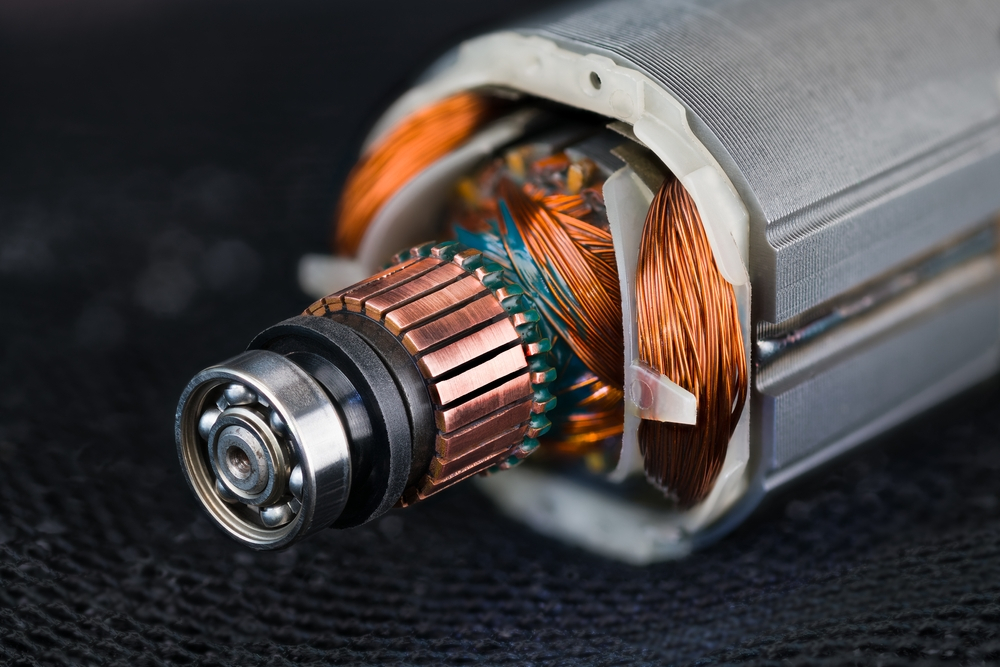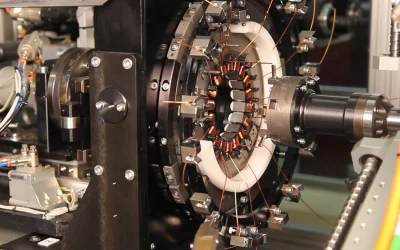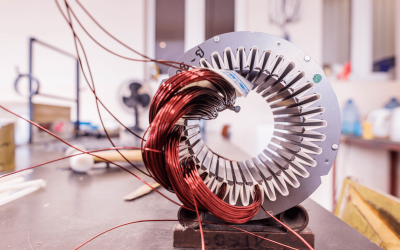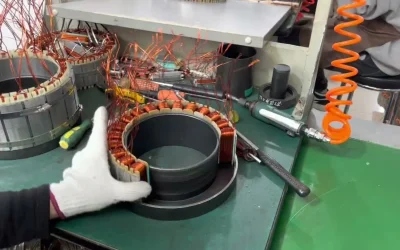A Beginner’s Guide to DC Motors: How They Work and Why They Matter

An important element in many machines and devices is the DC motor, which converts electrical energy into mechanical energy. They are of significant importance in many industries, from transportation and logistics to manufacturing.
In the realm of transportation, DC motors are pivotal in powering electric vehicles (EVs), where they provide the necessary torque and speed control for efficient operation.
Their ability to deliver high torque at low speeds is essential for vehicle acceleration, making them a preferred choice for EV manufacturers. In logistics, DC motors are employed in conveyor systems and automated sorting machines, ensuring smooth and efficient handling of goods.
A Beginner’s Guide to DC Motors
A direct current motor is an electrical machine that converts electric energy into mechanical energy using electromagnetic fields. The operating principle of a DC motor is simple and easy to understand: whenever a current-carrying conductor is placed in a magnetic field, it experiences a torque that causes the armature to rotate. This is the basic rule behind every DC motor.
How Important Are DC Motors in the Industry?
Due to their excellent efficiency, DC motors are used by many industries. They are typically used in applications where fine control of speed and torque is needed. Industries like transportation, manufacturing, and robotics rely on DC motors to drive their machines and equipment. Anyone working in these sectors needs to understand how they work.
Key Components of a DC Motor
Before diving into the operation of a DC motor, let’s first understand its basic components:
- Stator: The stator is the stationary part of the motor that creates the magnetic field. It can contain permanent magnets or electromagnets.
- Rotor (or Armature): The rotor is the rotating part of the motor that carries the winding through which current flows. It refers to the shaft on which the rotor is mounted.
- Commutator: The commutator reverses the current direction in the rotor, ensuring that the rotor keeps spinning in one direction.
- Electrical Brushes: These brushes convey power from the source to the commutator. Made of carbon, they wear out and need replacement periodically.
- Axle (Shaft): This is the shaft on which the rotor spins, and it is connected to the load driven by the motor.
Step by Step on How a DC Motor Works
Let us explain how a DC motor works in simple terms:
1. Power Up
When you plug a DC motor into the power source, electricity runs from the brushes to the rotor. This step is crucial as it starts up the motor.
2. Creating an Electromagnet
Electricity is sent to the wire coils in the rotor via a commutator, turning the rotor into an electromagnet. This interaction creates movement between the magnetic field and the non-magnetic rotor structure.
3. Magnetic Interaction
The electromagnetic field of the rotor interacts with the magnetic field of the stator. When the two fields intersect, a force is produced that makes the rotor turn. The force direction depends on the orientation of the magnetic fields.
4. Continuous Rotation
The commutator ensures the rotor always rotates forward by maintaining the electromagnetic field generated by the rotor, pushing against the stator’s magnetic field.
5. Mechanical Output
The spinning rotor can be linked to various units that perform work, providing mechanical output that operates other machinery and equipment.
The Role of the Commutator
The commutator is an important part of a DC motor. Here’s how it works:
- Segmented Design: The system is divided into different sections based on the wire coil arrangement in the rotor. This design allows for switching the current flow route at the right moments.
- Brush Contact: Brushes touch various sections of the commutator as the rotor spins. This changing contact is necessary for continuous circuit rotation.
- Reversing the Current in Rotor Winding: The commutator reverses the current direction in rotor windings, constantly orienting magnetic forces to drive the rotor in a single direction.
- Efficiency: A regularly serviced commutator provides smooth functioning and efficient energy conversion. Regular inspection and maintenance are important for good operation.
Types of DC Motors
There are different kinds of DC motors, each designed for specific applications:
1. Brushed DC Motors
The simplest and most widely used, consisting of a stator, rotor, brushes, and a commutator. They are often used in toys, small appliances, and automotive systems.
2. Brushless DC Motors
These use electronic controllers to manage current flow, omitting the need for brushes and commutators. They offer better efficiency, low maintenance, and long life, typical in hard disk drives and electric motors.
3. Permanent Magnet DC Motors
These do not use electromagnets in the stator but rely on permanent magnets, suitable for smaller, simpler-constructed motors used in robotics or portable tools.
4. Series DC Motors
Known for high starting torque, with field winding connected in series with the armature winding. They are used in applications requiring high torque.
5. Shunt DC Motors
With field winding connected in parallel with armature windings, they maintain constant speed under varying load conditions. They are used in applications requiring stable speed, like lathes and milling machines.
6. Compound DC Motors
Combining series and shunt motors, they provide a good combination of high starting torque and speed regulation, used in elevators and conveyors.
Advantages of DC Motors
The advantages of a DC motor include:
1. Easy Speed Control
DC motors can be operated with precise speed control, crucial for applications with specific speed requirements.
2. High Starting Torque
Many DC motors provide high starting torque, essential for applications with a load as soon as power is applied.
3. Compact Size
DC motors can be small and light, ideal for spaces with limited room.
4. Reversibility
Easily reversing the motor direction by changing power supply voltage polarity is useful in applications requiring quick directional change.
5. Simple Construction
DC motors are simpler than most other motor types, resulting in low-maintenance and inexpensive production.
6. Reliability
Properly maintained, they provide years of smooth operation, making them cost-effective for various applications.
Applications of DC Motors
DC motors are used in a variety of applications across many industries:
1. Transportation
Used in electric and hybrid vehicles, electric trains, and trams, including Tesla Inc.’s original Roadster Model S which was introduced in 2008.
2. Industrial Machinery
Used in conveyor belt systems, robotic arms, and automated assembly lines.
3. Mining Equipment
Used in drills, excavators, and conveyor belts, requiring robustness and high torque.
4. Power Tools
Frequently used in portable tools like cordless drills and saws.
5. Aerospace
Used in aircraft control surfaces, flaps, and landing gear.
6. Home Appliances
Used in vacuum cleaners, washing machines, and fans.
7. Robotics
Used to create motion, providing precise speed and torque control.
8. Medical Equipment
Used in infusion pumps and surgical robots, where reliability and precision are crucial.
Expanding on DC Motor Applications
DC motors are integral to numerous sectors, each with unique demands and challenges. Their versatility and adaptability make them indispensable in modern technology. Here’s a deeper look into some specific applications:
1. Electric Vehicles (EVs)
DC motors are crucial in EVs, providing the necessary torque and speed control for efficient operation. They are favored for their ability to deliver high torque at low speeds, which is essential for vehicle acceleration.
2. Renewable Energy Systems
In wind turbines and solar panel tracking systems, DC motors help in adjusting the position of the panels or blades to maximize energy capture. Their precision and reliability are vital for optimizing energy production.
3. Automation and Robotics
In automated systems, DC motors are used for precise control of movement and positioning. Robotics applications benefit from their ability to provide smooth and controlled motion, essential for tasks requiring high precision.
4. Agricultural Equipment
DC motors power various agricultural machines, such as automated feeders and irrigation systems. Their robustness and efficiency help in managing the demanding conditions of agricultural operations.
5. Marine Applications
DC motors are used in marine environments for propulsion and other onboard systems. Their ability to operate efficiently in harsh conditions makes them suitable for maritime applications.
Future Trends in DC Motor Technology
As technology advances, DC motors continue to evolve, incorporating new materials and designs to enhance performance and efficiency. Some emerging trends include:
1. Integration with IoT
DC motors are increasingly being integrated with IoT systems for real-time monitoring and control. This allows for predictive maintenance and improved operational efficiency.
2. Advanced Materials
The use of advanced materials in motor construction is leading to lighter and more durable motors. These materials improve thermal management and reduce energy losses.
3. Energy Efficiency Improvements
Ongoing research focuses on enhancing the energy efficiency of DC motors, reducing power consumption while maintaining performance. This is crucial for applications where energy conservation is a priority.
4. Customization and Modularity
Manufacturers are offering more customizable and modular motor designs to meet specific application needs. This flexibility allows for tailored solutions that optimize performance for particular tasks.
Challenges and Considerations
Despite their advantages, DC motors face challenges that need to be addressed:
1. Environmental Impact
The production and disposal of DC motors can have environmental impacts. Efforts are being made to develop more sustainable manufacturing processes and recycling methods.
2. Cost Considerations
While DC motors offer numerous benefits, their initial cost can be higher than other motor types. However, their long-term efficiency and reliability often justify the investment.
3. Technological Integration
As systems become more complex, integrating DC motors with other technologies can be challenging. Ensuring compatibility and seamless operation requires careful planning and execution.
Servicing Your DC Motors
To ensure a long life and efficacy of DC motors, regular maintenance is mandatory:
1. Brush Inspection
Brushes in a brushed DC motor wear out and require inspection, maintenance, and adjustment.
2. Commutator Maintenance
The commutator should be clean and may need resurfacing to ensure good electrical contact.
3. Bearing Lubrication
Adequate lubrication of bearings is critical for smooth operation and longevity.
4. Winding Checks
Regular checking of insulation in windings is required to avoid catastrophic failure.
5. Alignment Checks
Proper alignment with driven equipment is paramount for large motors.
6. Temperature Monitoring
Monitoring temperature during operation helps detect overheating issues.
Conclusion
DC motors have been a cornerstone of industry technology for over 100 years and remain prevalent in many sectors today. These versatile machines power everything from toys to mining equipment.
Here at CAM Innovation, we specialize in the design and fabrication of the very equipment needed for these maintenance and repair projects. This equipment allows us to service and repair large DC motors with minimal downtime for our customers.
Understanding how they function and how to maintain them is vital for those working in industries using these powerful machines. As advancements continue, they are poised to play an even more significant role in the future of automation, transportation, and energy systems.
Understanding their operation, maintenance, and potential applications is crucial for leveraging their full potential in any industry.
FAQs
How long do DC motors typically last?
Small brushed DC motors might work for a few thousand hours, while large industrial DC motors can last several decades with proper maintenance.
Can DC motors be used with AC power?
Although DC motors work with direct current, they can be used with AC power by adding a rectifier.
Are DC motors more efficient than AC motors?
Modern AC motors are typically more compact and efficient, while DC motors tend to have better starting torque with instantaneous speed change.
How often should DC motors be serviced?
Service intervals vary with runtime, motor size, type, and application. Large industrial DC motors may require service every few months, while smaller motors in less demanding applications may go years before needing servicing.



